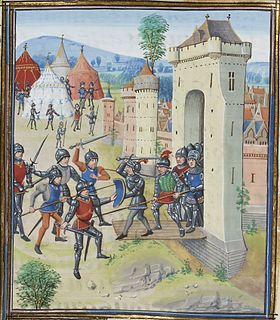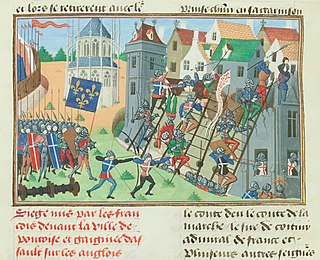
John Fitzalan, 7th Earl of Arundel, 4th Baron MaltraversKG was an English nobleman and military commander during the later phases of the Hundred Years' War. His father, John Fitzalan, 3rd Baron Maltravers, fought a long battle to lay claim to the Arundel earldom, a battle that was not finally resolved until after the father's death, when John Fitzalan the son was finally confirmed in the title in 1433.

The siege of Rouen was a major event in the Hundred Years' War, where English forces loyal to Henry V captured Rouen, the capital of Normandy, from the Norman French.

Château Gaillard is a medieval castle ruin overlooking the River Seine above the commune of Les Andelys, in the French department of Eure, in Normandy. It is located some 95 kilometres (59 mi) north-west of Paris and 40 kilometres (25 mi) from Rouen. Construction began in 1196 under the auspices of Richard the Lionheart, who was simultaneously King of England and feudal Duke of Normandy. The castle was expensive to build, but the majority of the work was done in an unusually short period of time. It took just two years and, at the same time, the town of Petit Andely was constructed. Château Gaillard has a complex and advanced design, and uses early principles of concentric fortification; it was also one of the earliest European castles to use machicolations. The castle consists of three enclosures separated by dry moats, with a keep in the inner enclosure.

Jean Bureau was a French artillery commander active primarily during the later years of the Hundred Years' War. Along with his brother, Gaspard, he is credited with making French artillery the most effective in the world. As Master Gunner of Artillery in the armies of Charles VII, Bureau acquired a reputation as an effective artillery officer during the Normandy campaign (1449–1450), when his bombardments helped capture the towns of Rouen, Harfleur, and Honfleur, and aided in the French victory at Formigny. Bureau commanded the victorious French army at the decisive Battle of Castillon in 1453.

Harfleur is a commune in the Seine-Maritime department in the Normandy region of northern France.
Events from the 1350s in England.
Events from the 1430s in England.

Rouen Castle was a fortified ducal and royal residence in the city of Rouen, capital of the duchy of Normandy, now in France. With the exception of the tower wrongly associated with Joan of Arc, which was restored by Viollet-le-Duc, the castle was destroyed at the end of the 16th century, its stones quarried for other construction.
Siege of Calais may refer to:

The siege of Calais of 1596, also known as the Spanish conquest of Calais, took place at the strategic port-city of Calais, between April 8–24, 1596, as part of the Franco-Spanish War (1595–1598), in the context of the French Wars of Religion, the Anglo-Spanish War (1585–1604), and the Eighty Years' War. The siege ended when the city fell into Spanish hands after a short and intense siege by the Spanish Army of Flanders commanded by Archduke Albert of Austria, Governor-General of the Spanish Netherlands. The French troops in the citadel of Calais resisted for a few days more, but finally on April 24, the Spanish troops led by Don Luis de Velasco y Velasco, Count of Salazar, assaulted and captured the fortress, achieving a complete victory. The Spanish success was the first action of the campaign of Archduke Albert of 1596.

Rouen, France, was founded by the Gaulish tribe of Veliocasses, who controlled a large area in the lower Seine valley, which today retains a trace of their name as the Vexin. The Gauls named the settlement Ratumacos and the Romans called it Rotomagus. Roman Rotomagus was the second city of Gallia Lugdunensis, after Lugdunum (Lyon). After the reorganization of the empire by Diocletian, Rouen became the chief city of the divided province of Gallia Lugdunensis II and reached the peak of its Roman development, with an amphitheatre and thermae, the foundations of which remain today. In the 5th century, it became the seat of a bishopric and later a capital of Merovingian Neustria.
Events from the year 1418 in France.

The siege of Aiguillon, an episode in the Hundred Years' War, began on 1 April 1346 when a French army commanded by John, Duke of Normandy, laid siege to the Gascon town of Aiguillon. The town was defended by an Anglo-Gascon army under Ralph, Earl of Stafford.
Lancaster's chevauchée of 1356 in Normandy was an English offensive directed by Henry, Duke of Lancaster, in northern France during 1356, as a part of the Hundred Years' War. The offensive took the form of a large mounted raid—a chevauchée—and lasted from 22 June to 13 July. During its final week the English were pursued by a much larger French army under King John II that failed to force them to battle.

The siege of Pontoise took place during the Hundred Years War. French forces led by King Charles VII of France besieged and captured the last English stronghold in Île de France, eliminating the English threat to Paris.
Siege of Bordeaux may refer to:
Siege of Valognes may refer to:
Siege of Avranches may refer to:
Siege of Domfront may refer to:
Siege of Bayonne may refer to:
This page is based on this
Wikipedia article Text is available under the
CC BY-SA 4.0 license; additional terms may apply.
Images, videos and audio are available under their respective licenses.









